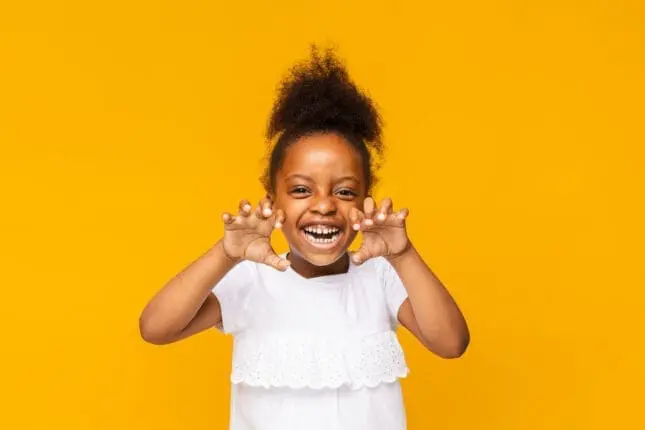Q: I can’t look anywhere without hearing about the benefits of mindfulness-based interventions for stress and anxiety. But how can I adapt these practices for the young kids I work with?
A: These days, we’re seeing increasing numbers of younger and younger kids struggling with anxiety. With some estimates suggesting a third of them are experiencing symptoms by adolescence, many clinicians are scrambling to find strategies that help kids manage stress in the moment and build resilience, without relying on medication. As the research shows, mindfulness techniques can be incredibly effective in this regard, but if the idea of teaching little kids to sit still and quietly focus on their breath strikes you as somewhere between absurd and impossible, you may be right.
The key, as with any kid-centered therapy, is to make it feel engaging. Sound easy? Not always! My first attempts at sharing mindfulness with kids, as a special education teacher and later as a clinician, were largely failures. After all, how are you supposed to make focusing on the breath feel fun? “Why are we doing this stupid stuff?” they’d often ask me. One particularly precocious child even told me, “Deep breathing is so played out!”
Then I came across a little study by Lev Vygotsky. A cognitive development researcher, he once attempted a brave experiment—asking a group of eight-year-olds to stand still for as long as they could. (Spoiler alert: if you’ve ever worked or lived with an eight-year-old, you can already guess how this one ends.) He gathered the group, pulled out his stopwatch, and instructed them to stand still. After less than five minutes—yep, you guessed it—they were all running around.
What he did next would be intuitive for anyone who lives or works with children: he corralled the kids together again and suggested a twist. “Let’s stand still again for as long as we can, but this time, I’d like you to imagine you’re a knight guarding a castle.” Lo and behold, the kids were able to stand still for almost 20 minutes.
In both scenarios, the kids activated their prefrontal cortex and anchored their attention to the task, quieting their limbic system in the process. But in the second one, the anchor was, well, a lot more fun. By tapping into the power of imagination, making it something of a game, a competition, and a performance, he helped the kids quadruple their attention span.
It may seem obvious now, but harnessing kids’ vivid imagination and sense of curiosity can help them practice mindfulness, especially when it becomes an activity the whole family can engage in. How do you start? Adults might understand that regulating the breath regulates the body’s physiology, which regulates the brain, which regulates our focus, impulses, and emotions—but kids respond better to metaphors. “Your breath is like a remote control for your brain,” I tell them. “You can use it to turn off the anxiety channel and turn up the volume on the relaxation channel. If your body is relaxed, your brain can’t be anxious at the same time.”
Here are a few fun breaths to help them learn to use this powerful remote control for their brains and bodies. Although these are just the ABCs, there’s a whole alphabet at our disposal!
A is for Alligator Breath. Hold your arms out like the jaws of an alligator. On the inbreath, stretch your jaws open wide like the alligator is yawning. On the outbreath, snap the jaws shut like it just ate something yummy. Try this a few of times—but remember not to bite your therapist!
This warm-up exercise, which combines movement and breathing, is a great way to loosen up while teaching about breath awareness. It’s a favorite with one of my seven-year-old clients, who taught it not only to his parents but to his four-year-old sister and three-year-old brother. Now, we always start family sessions this way, knowing that someone will get “bitten” at some point and laughter will carry us into the next practice.
B is for Butterfly Breath. Begin with palms together in front of you. On the inbreath, stretch your arms out and back, like you’re opening your wings. On the outbreath, bring them back together. As you fly, slowly flapping your wings, imagine you’re fluttering over a big field with lots of beautiful flowers and a nice, gentle river flowing through it.
After we get the sillies out with Alligator Breath, we settle into Butterfly Breath. Here, the four-year-old sister usually tells me that she sees fairies hanging out in the field of flowers. The mom, who often goes to yoga classes, once pointed out that this practice is also a great chest opener, allowing the lungs to bring in more oxygen with each flutter. It’s still fun, as with Alligator Breath, but settles us into slower, more regulated movements and breaths. Since butterflies aren’t for everyone, B can also stand for a bat flapping its wings silently in the night.
C is for Hot Chocolate Breath. Hold your hands up to your face as if you’ve got a full mug of steaming hot cocoa. If it’s too hot to drink, what do you? Blow out gently and steadily cooling it off, then breathe back in through your nose smelling the delicious chocolate. What could be a more fun way to “cool off” hot emotions like anxiety, anger, or frustration?
This is my all-time favorite breathing exercise for kids. It’s a lot more fun than being told to count to 10 when you feel upset. This practice really helps kids slow down and quiet their nervous system. It’s also a lot more portable that alligators or butterflies. In other words, in school or another social settings, if kids feel self-conscious holding up an imaginary mug, they can just breathe in slowly through their nose and blow out gently through their mouth: no one needs to know about the invisible hot chocolate in their mind.
Making It Stick
Of course, to make sure kids get the full benefit of these practices, they need to do them regularly outside therapy sessions. Plus, when families are practicing together, they’re regulating together: a reinforcing positive cycle. So I like to brainstorm with families the times they can all breathe together: Before bed? Before dinner? Before homework time? Or at transition times from home to school? The goal is to build some simple practices into the day, so that it feels accessible and fun, even at more difficult moments.
From there, it’s easy to get even more creative with finding moments to practice. I like to introduce practices into board games kids are already familiar with. For instance, on the Jenga blocks in my office I’ve written breathing and awareness practices, like “name three sounds you hear right now,” “practice three hot chocolate breaths,” and “name three sensations in your feet.” Similarly, with Candyland (a game surely designed to bore adults into a stupor), you can embed new rules that encourage mindful awareness, like “if you land on red, talk about how your body feels when you’re mad.” Add some breathing with a prompt to do a Butterfly Breath if you land on orange, an Alligator Breath on green.
The power of these simple practices is that as the kids get older, the practices can grow and develop with them. At age five, kids enjoy the hot chocolate image and holding their palms to their face; by 10, they can let their hands fall to the side, with just the image remaining; by 15, they can simply be aware of their breath, having now mastered the ability to regulate it, and thereby their body and brain.
Of course, mindfulness is far more than just breathing, but these kinds of fun activities start to introduce the concept and practice of awareness and regulation. I was thrilled when I got an email from a former client I’d seen when she was just a little kid. I was a newly minted therapist back then, trying to help her navigate the stress of her parents’ divorce. Her email described how she’d successfully applied her breathing practices to get through middle school and high school. In college, she’d even started a daily meditation practice. Now she was a nurse in a children’s hospital, a tough but ultimately rewarding job.
“Many of the kids on my ward are battling cancer and other debilitating illnesses,” she wrote. “But a highlight of our days is when we all meet in the lounge and do our breathing practices together. It puts a smile on their faces and a sense of peace in their bodies. And when the parents get involved, the benefits ripple out even more!”
Want to earn CE credits for reading this? Take the CE magazine quiz.
Christopher Willard
Christopher Willard, PsyD, is one of the world’s leading experts on mindfulness with young people, having trained thousands of professionals and young people on the practice and benefits of mindfulness. He is a psychologist and consultant based in Boston, working individually as well as consulting to schools, hospitals and other organizations. Additionally, he is the author of multiple books on psychology, child development, contemplative practice and more. Dr. Willard is the president of the Mindfulness in Education Network and serves on the board of directors at the Institute for Meditation and Psychotherapy. In addition to serving on the faculty of Harvard Medical School, Dr. Willard leads courses and workshops around the world and online. Dr. Willard is the co-author of The Mindfulness Skills Activity Book for Children (PESI, 2018), and the author of Child’s Mind (Parallax Press, 2010), Growing Up Mindful (Sounds True, 2016) and numerous others. He is also the co-author of the bestselling Growing Mindful (PESI, 2015), Growing Mindful 2nd Edition (PESI, 2019), Growing Mindful Spanish Edition (PESI, 2016), Growing Happy (PESI, 2016), Mindful Reminders (PESI, 2016), The Self-Compassion (PESI, 2016) and Anti-Burnout (PESI, 2017) card decks.













